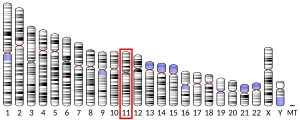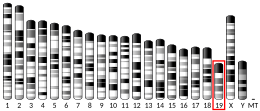Uteroglobin
Uteroglobin, or blastokinin, also known as secretoglobin family 1A member 1 (SCGB1A1), is a protein that in humans is encoded by the SCGB1A1 gene.[5]
SCGB1A1 is the founding member of the secretoglobin family of small, secreted, disulfide-bridged dimeric proteins found only in mammals.[6] This antiparallel disulfide linked homodimeric protein is multifunctional and found in various tissues in various names such as: uteroglobin (UG, UGB), uteroglobin-like antigen (UGL), blastokinin, club-cell secretory protein (CCSP), Clara-cell 16 kD protein (17 in rat/mice), club-cell-specific 10 kD protein (CC10), human protein 1, urine protein 1 (UP-1), polychlorinated biphenyl-binding protein (PCB-BP), human club cell phospholipid-binding protein (hCCPBP), secretoglobin 1A member 1 (SCGB1A1).[7]
This protein is specifically expressed in club cells in the lungs.[8]
Function
[edit]The precise physiological role of uteroglobin is not yet known. Putative functions are:
- Immunomodulation
- Progesterone binding: weak in some animals, especially weak in humans. (Note: UGB is itself progesterone induced gene in the endometrium in Lagomorphs)
- Inhibits phospholipase A2 in vitro
- Binds phosphatidylcholine, phosphatidylinositol
- Binds to fibronectin: The uteroglobulin knockout mice on the inbred C57Bl6 strain develop Goodpasture's syndrome like glomerulopathy due to fibronectin binding of IgA which might potentially be prevented by uteroglobin replacement. However contrary to the animal model claims, human genetic data might suggest that the effect may be indirect[9]
- Uteroglobin knockout mice on the inbred 129 strain appear to have healthy phenotype (no glomerulopathy development), but show physiological differences in their responses to respiratory challenges. The phenotype exhibited by these mice are; decreased bioaccumulation of biphenyls, susceptibility and increased IL-13, and IL-6 following hyperoxic challenge, and changes in the club cell morphology. [10]
- Target of polychlorinated biphenyl (pcb) binding
References
[edit]- ^ a b c GRCh38: Ensembl release 89: ENSG00000149021 – Ensembl, May 2017
- ^ a b c GRCm38: Ensembl release 89: ENSMUSG00000024653 – Ensembl, May 2017
- ^ "Human PubMed Reference:". National Center for Biotechnology Information, U.S. National Library of Medicine.
- ^ "Mouse PubMed Reference:". National Center for Biotechnology Information, U.S. National Library of Medicine.
- ^ Wolf M, Klug J, Hackenberg R, Gessler M, Grzeschik KH, Beato M, Suske G (September 1992). "Human CC10, the homologue of rabbit uteroglobin: genomic cloning, chromosomal localization and expression in endometrial cell lines" (PDF). Hum. Mol. Genet. 1 (6): 371–8. doi:10.1093/hmg/1.6.371. PMID 1284526.
- ^ Laukaitis CM, Karn RC (2005). "Evolution of the secretoglobins: a genomic and proteomic view". Biological Journal of the Linnean Society. 84 (3): 493–501. doi:10.1111/j.1095-8312.2005.00450.x.
- ^ Klug J, Beier HM, Bernard A, Chilton BS, Fleming TP, Lehrer RI, Miele L, Pattabiraman N, Singh G (2000). "Uteroglobin/Clara cell 10-kDa family of proteins: nomenclature committee report". Ann. N. Y. Acad. Sci. 923 (1): 348–54. Bibcode:2000NYASA.923..348K. doi:10.1111/j.1749-6632.2000.tb05549.x. PMID 11193777. S2CID 38862724.
- ^ Zhang, Liqian; Whitsett, Jeffrey A.; Stripp, Barry R. (1997). "Regulation of Clara cell secretory protein gene transcription by thyroid transcription factor-1". Biochimica et Biophysica Acta (BBA) - Gene Structure and Expression. 1350 (3): 359–367. doi:10.1016/S0167-4781(96)00180-7. PMID 9061032.
- ^ Vollmer M, Krapf R, Hildebrandt F (1998). "Exclusion of the uteroglobin gene as a candidate for fibronectin glomerulopathy (GFND)". Nephrol. Dial. Transplant. 13 (9): 2417–8. doi:10.1093/ndt/13.9.2417. PMID 9761542.
- ^ Stripp BR, Reynolds SD, Boe IM, Lund J, Power JH, Coppens JT, Wong V, Reynolds PR, Plopper CG (August 2002). "Clara cell secretory protein deficiency alters clara cell secretory apparatus and the protein composition of airway lining fluid". Am. J. Respir. Cell Mol. Biol. 27 (2): 170–8. doi:10.1165/ajrcmb.27.2.200200270c. PMID 12151308.
External links
[edit]- Bioinformatic_Harvester Archived 2007-06-21 at the Wayback Machine
Further reading
[edit]- Bernard A, Roels H, Lauwerys R, et al. (1992). "Human urinary protein 1: evidence for identity with the Clara cell protein and occurrence in respiratory tract and urogenital secretions". Clin. Chim. Acta. 207 (3): 239–49. doi:10.1016/0009-8981(92)90122-7. PMID 1395029.
- Singh G, Katyal SL, Brown WE, et al. (1988). "Amino-acid and cDNA nucleotide sequences of human Clara cell 10 kDa protein". Biochim. Biophys. Acta. 950 (3): 329–37. doi:10.1016/0167-4781(88)90129-7. PMID 3167058.
- Singh G, Singh J, Katyal SL, et al. (1988). "Identification, cellular localization, isolation, and characterization of human Clara cell-specific 10 KD protein". J. Histochem. Cytochem. 36 (1): 73–80. doi:10.1177/36.1.3275712. PMID 3275712.
- Jensen SM, Jones JE, Pass H, et al. (1994). "Clara cell 10 kDa protein mRNA in normal and atypical regions of human respiratory epithelium". Int. J. Cancer. 58 (5): 629–37. doi:10.1002/ijc.2910580503. PMID 7521325. S2CID 26539737.
- Umland TC, Swaminathan S, Singh G, et al. (1995). "Structure of a human Clara cell phospholipid-binding protein-ligand complex at 1.9 A resolution". Nat. Struct. Biol. 1 (8): 538–45. doi:10.1038/nsb0894-538. PMID 7664082. S2CID 28261246.
- Hay JG, Danel C, Chu CS, Crystal RG (1995). "Human CC10 gene expression in airway epithelium and subchromosomal locus suggest linkage to airway disease". Am. J. Physiol. 268 (4 Pt 1): L565–75. doi:10.1152/ajplung.1995.268.4.L565. PMID 7733299.
- Zhang Z, Zimonjic DB, Popescu NC, et al. (1997). "Human uteroglobin gene: structure, subchromosomal localization, and polymorphism". DNA Cell Biol. 16 (1): 73–83. doi:10.1089/dna.1997.16.73. PMID 9022046.
- Laing IA, Goldblatt J, Eber E, et al. (1998). "A polymorphism of the CC16 gene is associated with an increased risk of asthma". J. Med. Genet. 35 (6): 463–7. doi:10.1136/jmg.35.6.463. PMC 1051339. PMID 9643286.
- Zheng F, Kundu GC, Zhang Z, et al. (1999). "Uteroglobin is essential in preventing immunoglobulin A nephropathy in mice". Nat. Med. 5 (9): 1018–25. doi:10.1038/12458. PMID 10470078. S2CID 12203973.
- Müller-Schöttle F, Classen-Linke I, Alfer J, et al. (2000). "Expression of uteroglobin in the human endometrium". Mol. Hum. Reprod. 5 (12): 1155–61. doi:10.1093/molehr/5.12.1155. PMID 10587371.
- Kundu GC, Zhang Z, Mantile-Selvaggi G, et al. (2001). "Uteroglobin binding proteins: regulation of cellular motility and invasion in normal and cancer cells". Ann. N. Y. Acad. Sci. 923: 234–48. doi:10.1111/j.1749-6632.2000.tb05533.x. PMID 11193760. S2CID 7571620.
- Burmeister R, Boe IM, Nykjaer A, et al. (2001). "A two-receptor pathway for catabolism of Clara cell secretory protein in the kidney". J. Biol. Chem. 276 (16): 13295–301. doi:10.1074/jbc.M010679200. PMID 11278724.
- Matsunaga A, Numakura C, Kawakami T, et al. (2002). "Association of the uteroglobin gene polymorphism with IgA nephropathy". Am. J. Kidney Dis. 39 (1): 36–41. doi:10.1053/ajkd.2002.29875. PMID 11774099.
- Ghafouri B, Ståhlbom B, Tagesson C, Lindahl M (2002). "Newly identified proteins in human nasal lavage fluid from non-smokers and smokers using two-dimensional gel electrophoresis and peptide mass fingerprinting". Proteomics. 2 (1): 112–20. doi:10.1002/1615-9861(200201)2:1<112::AID-PROT112>3.0.CO;2-N. PMID 11788998. S2CID 34355853.
- Narita I, Saito N, Goto S, et al. (2002). "Role of uteroglobin G38A polymorphism in the progression of IgA nephropathy in Japanese patients". Kidney Int. 61 (5): 1853–8. doi:10.1046/j.1523-1755.2002.00336.x. PMID 11967037.
- Shijubo N, Itoh Y, Abe S (2002). "[Anti-inflammatory molecule, Clara cell 10 kilodalton protein and respiratory diseases]". Rinsho Byori. 50 (4): 370–3. PMID 12014016.
- Chowdhury B, Mantile-Selvaggi G, Miele L, et al. (2002). "Lys 43 and Asp 46 in alpha-helix 3 of uteroglobin are essential for its phospholipase A2 inhibitory activity". Biochem. Biophys. Res. Commun. 295 (4): 877–83. doi:10.1016/S0006-291X(02)00767-2. PMID 12127976.
- Coppo R, Chiesa M, Cirina P, et al. (2002). "In human IgA nephropathy uteroglobin does not play the role inferred from transgenic mice". Am. J. Kidney Dis. 40 (3): 495–503. doi:10.1053/ajkd.2002.34890. PMID 12200800.
- Navab R, Wang Y, Chow YH, et al. (2002). "Regulation of human Clara cell 10 kD protein expression by chicken ovalbumin upstream promoter transcription factors (COUP-TFs)". Am. J. Respir. Cell Mol. Biol. 27 (3): 273–85. doi:10.1165/rcmb.2002-0014oc. PMID 12204889.




